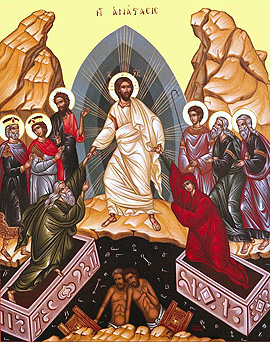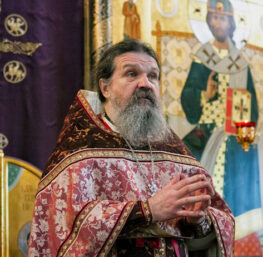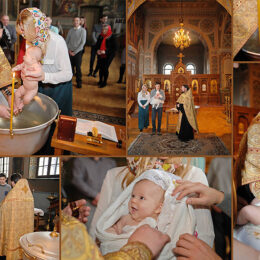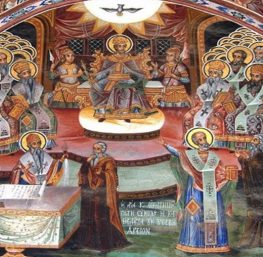![]() Let God arise, let His enemies be scattered; let those who hate Him flee from before His face!
Let God arise, let His enemies be scattered; let those who hate Him flee from before His face!
Christ is risen from the dead, trampling down death by death, and upon those in the tombs bestowing life.
This is the day which the Lord has made, let us rejoice and be glad in it!
This is the Day of Resurrection. Let us be illumined, O people. Pascha, the Pascha of the Lord. For from death to life and from earth to heaven has Christ our God led us, as we sing the song of victory. Christ is risen from the dead! (Ode 1 of Pascha Canon)
Pascha (Greek: Πάσχα), also called Easter, is the feast of the Resurrection of the Lord. Pascha is a transliteration of the Greek word, which is itself a transliteration of the Hebrew pesach, both words meaning Passover.
A little before midnight on the Blessed Sabbath the Nocturne service is chanted. The celebrant goes to the tomb and removes the winding-sheet. He carries it through the royal doors and places it on the altar table where it remains for forty days until the day of Ascension.
 At midnight the Easter procession begins. The people leave the church building singing: The angels in heaven, 0 Christ our Savior, sing of Thy resurrection. Make us on earth also worthy to hymn Thee with a pure heart.
At midnight the Easter procession begins. The people leave the church building singing: The angels in heaven, 0 Christ our Savior, sing of Thy resurrection. Make us on earth also worthy to hymn Thee with a pure heart.
The procession circles the church building and returns to the closed doors of the front of the church. This procession of the Christians on Easter night recalls the original baptismal procession from the darkness and death of this world to the night and the life of the Kingdom of God. It is the procession of the holy passover, from death unto life, from earth unto heaven, from this age to the age to come which will never end. Before the closed doors of the church building, the resurrection of Christ is announced. Sometimes the Gospel is read which tells of the empty tomb. The celebrant intones the blessing to the “holy, consubstantial, life-creating and undivided Trinity.” The Easter troparion is sung for the first time, together with the verses of Psalm 68 which will begin all of the Church services during the Easter season.
Let God arise, let his enemies be scattered; let those who hate him flee from before his face!
Christ is risen from the dead, trampling down death by death, and upon those in the tombs bestowing life. (Troparion)
This is the day which the Lord has made, let us rejoice and be glad in it!
The canon hymns of Christ’s resurrection. ascribed to St John of Damascus, are chanted with the troparion of the feast as the constantly recurring refrain. The building is decorated with flowers and lights. The vestments are the bright robes of the resurrection. The Easter icon stands in the center of the church showing Christ destroying the gates of hell and freeing Adam and Eve from the captivity of death. It is the image of the Victor “trampling down death by his own death.” There is the continual singing and censing of the icons and the people, with the constant proclamation of the celebrant: Christ is risen! The faithful continually respond: Indeed he is risen!
It is the day of resurrection ! Let us be illumined for the feast! Pascha! The Pascha of the Lord! From death unto life, and from earth unto heaven has Christ our God led us! Singing the song of victory: Christ is risen from the dead! (First Ode of the Easter Canon)
Following the canon, the paschal verses are sung, and at the conclusion of the Easter Matins, the Easter Hours are also sung. In general, nothing is simply read in the Church services of Easter: everything is fully sung with the joyful melodies of the feast.
At the end of the Hours, before the Divine Liturgy, the celebrant solemnly proclaims the famous Paschal Sermon of St. John Chrysostom. This sermon is an invitation to all of the faithful to forget their sins and to join fully in the feast of the resurrection of Christ. Taken literally, the sermon is the formal invitation offered to all members of the Church to come and to receive Holy Communion, partaking of Christ, the Passover Lamb, whose table is now being set in the midst of the Church. In some parishes the sermon is literally obeyed, and all of the faithful receive the eucharistic gifts of the Passover Supper of Easter night.
The Easter Divine Liturgy begins immediately with the singing once more of the festal troparion with the verses of Psalm 68. Special psalm verses also comprise the antiphons of the liturgy, through which the faithful praise and glorify the salvation of God:
Make a joyful noise to the Lord, all the earth! Sing of his name, give glory to his praise.
Let all the earth worship Thee and praise Thee! Let it praise Thy name, 0 most High!
That we may know Thy way upon the earth and Thy salvation among all nations.
Let the people thank Thee, O God! Let all the people give thanks to Thee.
More on the Holy Pashca services available here.
![]()



